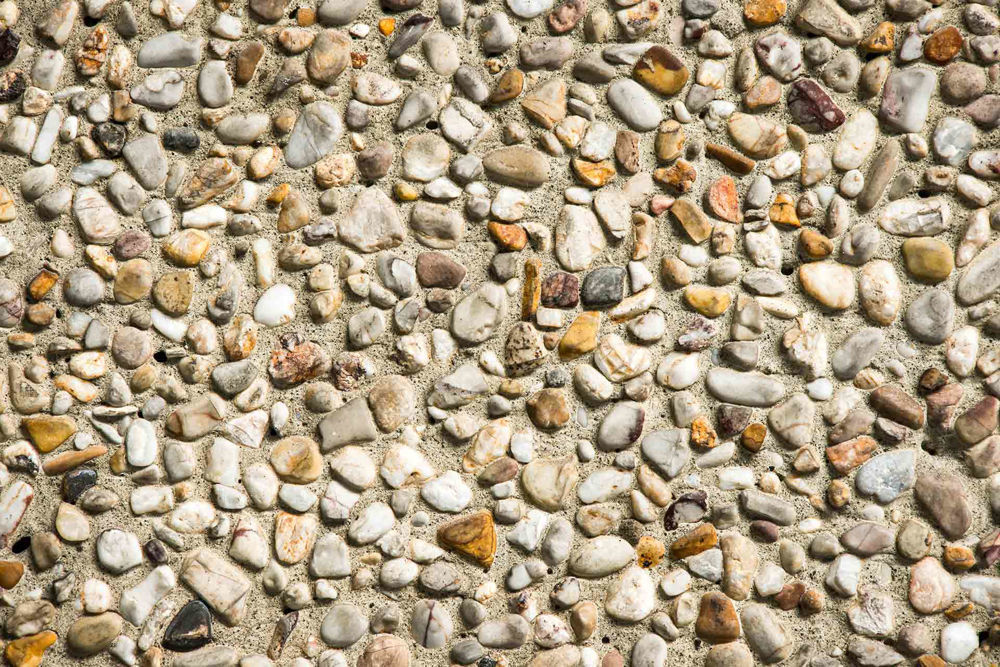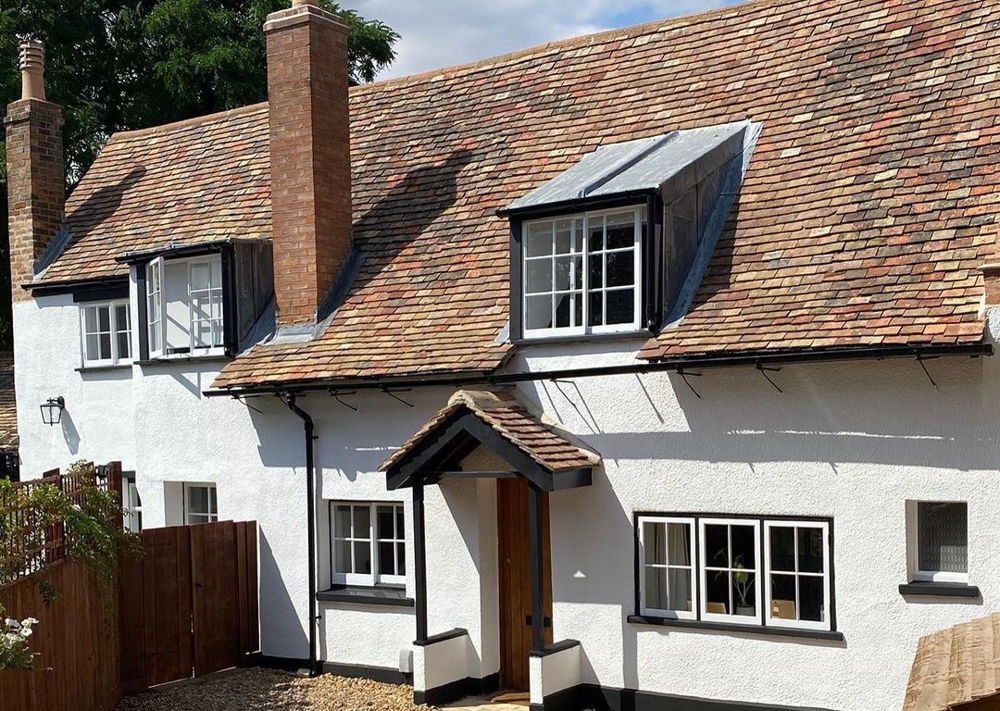
What Is Pebbledash?
Firstly, let's answer the question what is pebbledash? Well, pebbledash is a very course form of render used on exterior walls. Pebbledash is made up of cement and lots of small stones & rocks that are thrown on to a wet surface to create an even coating across the wall. While pebbledash involves putting the stones on the top of cement, a similar form of pebbledash is roughcast, which involves mixing the cement and the stones together and then applying.
Unfortunately, pebbledash has grown out of favour in the UK, which gives it an outdated reputation. This has led to many experts stating that it can actually devalue a property due to this. Understandably, this has led many people to want to provide a more modern look to their property by either removing or painting their pebbledash render.
Can You Remove Pebbledash?
If you are looking to get rid of pebbledash completely from your property, then it can be removed, but there are a few things to consider.
Underneath the render, their is little way to determine the condition of the property. The structure may be perfectly healthy underneath, however removing the render in some cases could reveal a whole host of issues. It may reveal poor brickwork, damp problems & crumbling pointing that have been hidden for some time. Because of this, it is crucially important that if you are planning on removing pebbledash, that you are prepared for the worst eventuality.
It is possible to remove pebbledash yourself but it is a difficult task. This means that it is your best option to get a professional to remove this, plus they will be most likely required to undertake any remedial work even if you managed to strip the pebbledash yourself.
The cost of this can vary. Checkatrade estimate that having pebbledash is likely to cost £2,100 to £7,800 depending on the size of the property. This does not include the remedial work or any painting of the property.
Can You Paint Peddledash?
Alternatively, can you paint pebbledash? Yes, luckily you can paint over pebbledash! Having said this, it is known as one of the most difficult exterior surfaces to paint, so it is important to properly research this before undertaking to ensure you get the finish you are looking for.
As with any exterior painting project, you must ensure you use the best tools & that you prepare the surface correctly. These two steps are often overlooked by DIY'ers but are known in the decorating trade as the two most important aspects of painting & decorating.
Firstly, let's talk about the tools you will need to paint pebbledash. Paint on pebbledash works in exactly the same way as paint on smooth surfaces, in the fact that if moisture can get behind the surface it will peel & flake.
Many people ask, what paint should you use on pebbledash? It is crucial to use both a waterproof & breathable masonry paint, which will keep moisture out by creating a water repellent surface but will also allow water vapour to escape from inside the surface. This is what many 'sealants' do not do, they seal the surface completely which yes keeps rain out of the surface, but as moisture cannot escape from inside the wall, leads to substantial damage to the property. We cannot emphasise this enough!
This is why Emperor Masonry Paint was developed, which creates a super hydrophobic (ultra water-repellent) surface on exterior walls without affecting the breathability. This allows the paint to remain completely unaltered in performance or aesthetic for longer than 25 years. In fact, while it is proven to last 25 years, we are so confident the paint will far exceed this, we actually offer a lifetime guarantee on Emperor Masonry Paint.

Once you have the right exterior paint for the job, it's important to then get the correct equipment to apply it.
YOU WILL NEED:
- Long-pile roller
- Paint tray
- Masonry brush
- Dust brush
- Sand paper
- Dust sheets
- Window film
- Masking tape
The equipment needed to paint pebbledash is similar to any other painting project with the difference of the roller & brush. Ensure you get a long-pile roller, which is perfect for painting heavily textured surfaces as it can reach the gaps between the pebbles much more effectively than a standard roller.
Furthermore, a specialist masonry brush with longer bristles will also help you find those tricky nooks and crannies. When finding the right equipment, we recommend you buy the most expensive you can afford. The better the quality, the better the finish you will achieve. While it is tempting to save money on these tools, especially if you do not paint very often, this is a false economy! Doing the job correctly first time round will save you huge amounts of money long-term.
1. PREPARE THE SURFACE
As we have previously mentioned, preparation is one of the most important aspects of any painting project. Removing any dirt and decontaminating the surface is the first task. Use a dust brush to remove any visible dirt & dust from the surface. Once this is done, assess walls for any signs of cracks or damage and if required use exterior filler to make any repairs.
Ensuring the surface is dry, apply the Emperor Paint Exterior Masonry Cleaner. This removes moss and algae by disinfecting the surface, killing any bacteria and ensuring that no growth occurs underneath the painted surface. Allow the cleaner to dry and be absorbed into the surface of the building for a minimum of two hours to fully disinfect the wall. After the two hours, simply wash the surface with a hose to remove any residue.
The next step is to apply a primer if the pebbledash is not already painted. You should always use a wall primer on any non-painted surface, as the primer is what ensures the paint can adhere to the wall. Primers are a clear liquid that can be applied using a paint roller, brush or pump sprayer. The thin primer is extremely easy to apply and only needs one coating.
2. PAINTING THE PEBBLEDASH
First, ensure you have a dust sheet down and that all trim on your home is covered. A great tip is to cover drainpipes in newspaper!
Starting at the top, work downwards and around the edges of the wall you are painting. You may find that using a masonry brush for the first coat will be easier as it will allow you to get an even coating across the full surface. You could try using a roller, however it may not get in all of the gaps where the paint needs to be applied.
Be aware that due to the coarse surface, it will take a lot more paint than with a smooth paint. A 10 litre tub of Emperor Masonry Paint will cover 10 metres squared, so an average mid terrace would need roughly four of these.
Allow the first coat to dry for a minimum of three hours and then apply the second coat. Luckily, this should not take as long as the first coat! The long pile roller is ideal for the second coat as it will give you a lovely even finish.
For full details on the painting process & to find out how much paint you will need, visit our paint coverage calculator.

Does Pebbledash Cause Damp?
A common occurrence will pebbledashed properties is the presence of damp. In short, damp comes in two forms; rising damp & penetrating damp. While rising damp occurs from the ground, penetrating damp is caused at any level of the building from water ingress on an exterior wall.
One of the main causes of penetrating damp cracked cement, bricks or pebble dash, which allows the moisture to soak into the property. While pebbledash itself is a protective barrier, it is often used to cover damaged bricks. Furthermore, as with any render, the pebbledash can breakdown, leaving gaps in the protective barrier. Once even the smallest gap opens up, moisture can get underneath the render and soak into the exterior wall. This will only worsen over time.
By creating a waterproof & breathable barrier, Emperor Masonry Paint has been shown to significantly reduce penetrating damp by preventing water ingress on a range of surfaces including pebbledash. While pebbledash does not cause damp, it is just as prone as bare brick to water ingress, which is what leads to paint failure.
How Do I Repair Textured Surfaces?
A common problem with all rendered surfaces is uneven finishes as a result of repairs made to cracks and holes. These surfaces once repaired can stick out and draw attention, which is the last thing you want when giving your home a new look. In order to help with covering these problems, we developed Emperor Textured Basecoat, which can be applied to exterior masonry surfaces in order to create a wide range of finishes. It is applied via brush or textured roller to cover surfaces and create a seamless textured finish. Crucially, it contains the same highly breathable nano-technology as our Emperor Masonry Paint, meaning the performance of your walls is not compromised.

Have any more questions regarding painting pebbledash? Our team of experts is on hand to assist you with any questions you may have. Talk to one of our experts today or shop Emperor Masonry Paint today & get FREE delivery on all orders.

